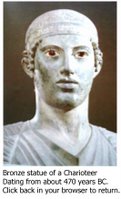Portrait History #1
 Portrait history from the fourth century BC to the present day.
Portrait history from the fourth century BC to the present day.Many of the most famous works of classical art which were admired in later times as representing the most perfect types of human beings are copies or variants of statues which were created in this period, the middle of the fourth century BC. The Apollo belvedere shows the ideal model of a mans body.
There were many portraits of the human body in these times like Venus which were designed to be seen from the side, and we can admire the clarity and simplicity with which the artist modelled the beautiful body. (Apollo Belvedere) Of course, this method of creating beauty by making a general and schematic figure more and more lifelike until the marble's surface seems to live and breathe has one drawback. It was possible to create convincing human types by this means, but would t
 his method ever lead to to the representation of real individual human beings. Strange as it may sound to us, the idea of a portrait, in the sense that we use the word, did not occur to the Greeks until rather late in the fourth century.
his method ever lead to to the representation of real individual human beings. Strange as it may sound to us, the idea of a portrait, in the sense that we use the word, did not occur to the Greeks until rather late in the fourth century. True we hear of portraits made in earlier times, but these statues were probably not good likenesses. A portrait of a general was little more than a picture of any good looking soldier with a helmet and a staff. The artist never reproduced the shape of his nose, the furrows of his brow, or his individual expression. In the generation of praxiteles, towards the end of the fourth century artists discovered means of animating the features without destroying there beauty. more than that they learned how to seize the workings of the individual soul and make portraits in our sense of the word.

0 Comments:
Post a Comment
<< Home